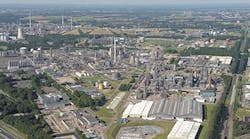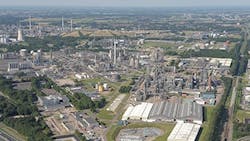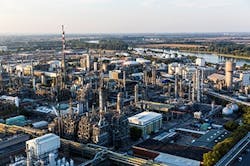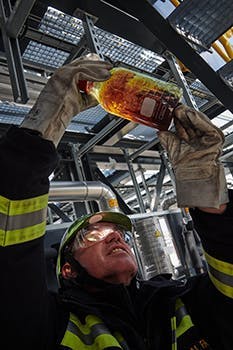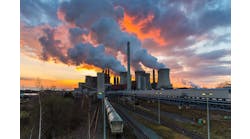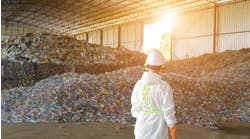Mid-January saw what promises to be a significant move in the global push to tackle the problem of plastic waste. Thirty global companies involved in all aspects of the plastics value chain, from chemical and plastic manufacturers to consumer goods companies, retailers and waste management firms launched the Alliance to End Plastic Waste (AEPW). The AEPW counts companies such as BASF, Dow, LyondellBasell, Procter & Gamble, Sasol and Shell among its members. It plans to invest $1.5 billion over the next five years to develop and bring to scale technologies and strategies that will help minimize and manage plastic waste and promote a circular economy, i.e., using waste and end-of-life materials to lessen input of fresh feeds and energy.
Meanwhile, Pathway21, launched in 2017, has developed a cloud-based materials marketplace concept to foster materials reuse around the world. Participants — more than 1,000 already take part in the organization’s national and regional materials marketplaces — sign up and provide information about reusable materials and services they want to trade, sell or purchase. The marketplace actively analyzes materials desired and available, and sends participants curated matches. Joining materials marketplaces and listing and searching for material is free; a participant only pays a fee based on the value of a transaction once it’s completed.
Regional initiatives also are underway, notably in the European Union (EU). Its “Strategy for Plastics in a Circular Economy,” adopted in January 2018 (see, “Europe Eyes Plastic Recycling Efforts”), sets ambitious objectives for recycling of plastics and reuse of plastic packaging that currently accounts for 27 million mt/yr of post-consumer plastic waste generated in member states. For example, the goal is to recycle 55% of plastic packaging by 2030.
The strategy provided a timely spur to technology developers keen to recycle this waste and reuse it as a raw material in chemical processes. The result has been a rash of announcements by companies including SABIC, BASF, OMV and Neste about investments in these technologies.
Upgrading Project
In December, SABIC, Sittard, the Netherlands, announced it had signed a memorandum of understanding with plastics recycling specialist Plastic Energy, London, to build a plant for the supply of feedstock to support SABIC’s petrochemical operations in Europe. The facility — expected to begin commercial production in 2021 — will be the first commercial one in the Netherlands to refine and upgrade Plastic Energy’s TACOIL feedstock.
The U.K. company has developed a thermal anaerobic conversion (TAC) process to produce TACOIL from raw, end-of-life or contaminated plastic waste. The feed material undergoes mechanical pre-treatment to remove unusable components such as metals and heavier plastics, leaving behind the usable portion — low density polyethylene (LDPE), high density polyethylene (HDPE), polystyrene (PS) and polypropylene (PP). The usable waste then is heated in the absence of oxygen until it melts and the polymer molecules break down to form a rich saturated vapor. After removal of non-condensable gases, the condensable gases produced during the process are converted to hydrocarbon products; atmospheric distillation columns split the hydrocarbon vapor into raw diesel, light oil and synthetic gas fractions. The non-condensable gases are burned to provide energy for the process.
While not revealing the scale of SABIC’s investment in the upgrading plant, Frank Kuijpers, general manager corporate sustainability at SABIC, says the facility probably would supply about 15,000 mt/yr of upgraded pyrolysis oil suitable for use at the naphtha crackers at its Geleen site (Figure 1).
Figure 1. A new pyrolysis oil upgrade plant at Geleen site in the Netherlands will supply feedstock for naphtha crackers. Source: SABIC.
“The liquid resulting from the mixed plastic waste conversion process cannot be directly processed in SABIC’s crackers and therefore must be upgraded in the new unit that will upgrade the pyrolysis oil, bringing it into the specification limits of our naphtha cracker,” Kuijpers explains.
“The unit will process low-end, mixed plastic waste that is expected to come from the Netherlands and which would otherwise be incinerated,” he adds.
The TACOIL process appealed because it already has been successfully commercialized and can handle a wide range of plastics that otherwise would be very hard to recycle by conventional processes, notes Kuijpers.
Once the facility starts up, SABIC’s plan is to work on the engineering required for scaleup of the pre-treatment technology, develop a strong market demand for its own certified circular polymers and — if these efforts pan out — scale up production at the new plant.
Plastic Energy CEO Carlos Monreal says SABIC’s interest in the technology stems from three factors: three years of experience of managing the TACOIL process through the full value chain; knowledge gained from two commercial plants already in operation in southern Spain — especially in terms of plant modularity and technology scalability; and the product quality.
“What we have been able to do [at our Almeria and Seville plants] is improve the quality of output from end-of-life plastic waste and adjust our technology in order to create the feedstock that chemical companies can process in their facilities to produce clean, recycled plastics. Each plant in Spain is operating 24/7, with stable and reliable yields,” he stresses.
Plastic Energy now is working to find the optimal feedstock to improve the new plant’s economics and energy efficiency.
“Although these are big challenges, the main challenge for us today is the policy environment because, despite higher recycling rates, chemical recycling is not properly recognized and incentivized,” notes Monreal.
The company also is talking with other chemical manufacturers about using TACOIL. “We are investigating opportunities in various markets, including the U.S. Based on our three years’ operational experience, we are ready to develop, build and operate multiple plants in different countries, with the goal to process over 200,000 tonnes [mt] of end-of-life plastic waste by the end of 2020,” he says.
Customer Trials Underway
Also in December, BASF, Ludwigshafen, Germany, announced progress in plastic waste recycling via its ChemCycling program. In a pilot project at Ludwigshafen, the company manufactured its first trial products using pyrolysis oil made from chemically recycled plastic waste. The pyrolysis oil goes to a steam cracker (Figure 2).
Figure 2. Unit at Ludwigshafen has successfully processed pyrolysis oil produced from waste plastic. Source: BASF.
The trial involves ten customers from different industries. Products manufactured so far include cheese packaging, refrigerator components and insulation panels. The customers currently are testing these to see how they compare with traditionally manufactured versions.
The pyrolysis oil itself was produced by Recenso, Remscheid, Germany. Its single-step catalytic tribochemical conversion (CTC) liquefaction technology combines catalytic and tribochemical mechanisms to crack the hydrocarbons in a variety of materials including agricultural waste biomass and mixed plastic waste. CTC doesn’t require high temperatures, pressures, or the addition of hydrogen into the process.
“As a next step, BASF plans to make the first products from the ChemCycling project commercially available. [However] …we currently cannot offer a detailed timeline due to prevailing technological and regulatory challenges that still need to be addressed,” notes a spokeswoman.
BASF currently is assessing various options and technologies, including which of two thermochemical processes — gasification or pyrolysis — is more suitable. “Neither is new, but they have not yet been used on a large scale to manufacture new chemicals. Availability and product specification of pyrolysis oil in the market need to be established. That is why we are currently investigating which process can best be scaled up to an industrial scale,” she says.
Another issue is whether the use of pyrolysis oil or syngas from plastic waste can overcome some regulatory ambiguities. For example, current EU legislation doesn’t oppose this approach — not least because chemical recycling barely plays a role in today’s waste management landscape.
“Chemical recycling is not yet recognized as a process which contributes to fulfilling the plastic packaging waste recycling quotas, especially in Germany. We are optimistic that demonstrating technology, market demand and environmental benefits, we can provide good arguments why chemical recycling should be seen as a valuable addition to a circular economy, and should meet supportive legislative conditions,” adds the spokeswoman.
Bigger Pilot Plant
Meanwhile, OMV, Vienna, is ramping up development efforts. The company has been exploring the potential of used plastics with its ReOil technology since 2011, and started up its first test facility, with a capacity of about 5 kg/hr of used plastic, at its Schwechat refinery in 2013. Last year, it began operating a test facility with a plastic processing capacity of up to 100 kg/hr that can produce 100 L/hr of synthetic crude (Figure 3).
The ReOil processes involves feeding used plastics into a smelting facility and then adding a solvent (which is recovered after processing and reused). This creates a fluid viscous mass that enhances heat conductivity and eases breaking the plastic down via a thermal cracking process operating at over 300°C. The process yields a usable gas and a syncrude. The refinery can process both to make gasoline, diesel and a polymer material used in plastics manufacturing.
“Currently the focus of OMV is to learn from the ReOil pilot plant and to prepare the next scale-up step. We are still acquiring operating as well as maintenance experience with this plant. A key focus beside the technology scale-up development is to establish standard procedures, to verify them and to optimize them,” notes Thomas Gangl, senior vice president refining & petrochemicals.
A future scale-up could handle more than a third of Austria’s plastic waste, he believes, as long as it contains high levels of PE, PP and PS.
“The feedstock used in the ReOil process should contain only small amounts of polymers such as PVC [polyvinyl chloride] and PET [polyethylene terephthalate]. PET plastic contains oxygen molecules and is thereby only partially suitable (in very low proportions) for the ReOil process. The ideal feedstock contains common packaging materials PE, PP and PS, from household items such as yoghurt pots, shampoo bottles, plastic bags, plastic cups, lids from takeaway coffee, carton packaging, filling material, bubble wrap and confectionery packaging,” Gangl explains.
OMV has invested around €10 million ($11.4 million) in the project so far, with the Austrian Research Promotion Agency subsidizing 10% of these costs.
Crude Oil Replacement
Last July, Neste, Espoo, Finland, announced plans to use liquefied waste plastic in a development project. The company is aiming for an industrial-scale trial this year and eventually to process more than 1 million mt/yr of plastic waste by 2030.
“To reach this target, development of processing technologies, supply chains, markets and regulation is still needed. Neste is actively working to accelerate development and make sure using waste plastic as a raw material becomes a viable alternative from technical, financial, sustainability as well as regulation standpoint,” says Heikki Färkkilä, vice president, oil products development.
As part of this strategy, Neste is involved with Licella, Sydney, Australia, and ReNew ELP, Redcar, U.K. For over a decade, Licella has been developing a hydrothermal upgrading platform called the catalytic hydrothermal reactor (Cat-HTR). This can transform a wide range of products — including waste plastic — into a biocrude suitable for producing biofuels and chemicals. (See: “Is Supercritical Water The Green Future of Chemical Processing.”) ReNew ELP, which has licensed the technology, currently is investing in a 120,000-t/yr plant at its Redcar site — the first commercial application of Cat-HTR technology.
However, Neste is more interested in the refinery processing of its liquefied waste plastic products than the liquefaction technology itself.
“Our intent here is to trial replacing crude oil — to an extent — as a refinery raw material while still producing high quality end products. We want to learn about the liquefied waste plastic oils’ processability and behavior rather than the liquefaction processes required to create them,” adds Färkkilä.
He also notes that Neste isn’t limiting its activities in this area to just the one liquefaction technology.
